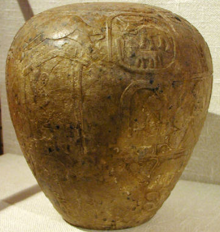- Narmer Macehead
-
The Narmer macehead is an ancient Egyptian decorative stone mace head. It was found during a dig at Kom al Akhmar, the site of Hierakonpolis (ancient Egyptian Nekhen.) It is dated to the reign of king Narmer whose serekh is engraved on it. Today it is kept at the Ashmolean Museum, Oxford.
Motifs
The macehead may represent the dynastic marriage of the victorious Narmer, pharaoh of Upper Egypt with Nithotep or Neithhotep A, a princess of the defeated Lower Egypt. Narmer wears the red crown of Lower Egypt and over him hovers the protective vulture, Nekhbet local goddess of Nekhen, the religious and political capital of predynastic Upper Egypt . Behind the princess appears a proto-Nine bows, which in later times represented the enemies of Egypt.[1]
The Narmer macehead is better preserved than the Scorpion macehead and has had various interpretations. Nowadays the opinion is, like for the Palette, that the events depicted on it records the year it was manufactured and presented to the temple, a custom which is known from other finds at Hierakonpolis, rather than great occasions like Narmer's Heb Sed festival or marriage to a possible Queen Nithotep, a theory of earlier scholars, among them Petrie.On the left side of this macehead we see a king wearing the Red Crown (deshret) sitting under a canopy on a dais, covered in a long cloth or cloak. He is holding the flail and above the canopy a vulture hovers with spread wings, possibly the deity Nekhbet. Directly in front of him is another dais or possibly litter on which sits facing him a cloaked figure. This figure has been interpreted as a princess being presented to the king for marriage, though it could also represent a deity. The dais is covered by a bowlike structure and behind it are three registers. In the center register attendants are walking or running behind the dais. In the top register an enclosure with what seems like a cow and a calf might symbolise a nome or the goddess Het-Hert (Hathor) and her son Heru (Horus), deities associated with kingship since earliest times. Behind the enclosure four standardbearers approach the throne. In the bottom register, in front of the fanbearers, are seen what looks like a collection of offerings.
On the center part of the macehead, behind the throne with the seated king there is a figure just like the supposed sandalbearer from the Narmer palette, likewise with the palmette sign above its head. He is followed by a man carrying a long pole. Above him three men are walking, two of them likewise carrying long poles. The serekh displaying the signs for Narmer can be seen above these.
The top field to the right of the center field shows a building, perhaps a shrine, with a heron perched on its roof. Below this, an enclosure shows three animals, probably antelopes. This has been suggested as signifying the ancient town of Buto, the place where the events described on the macehead might have taken place. An interesting discussion of these can be found here.
It has been debated whether Narmer was the last king of Dynasty 0 or the first king of Dynasty I and if he preceded or was contemporary with 'Scorpion' or even the same person. It is also questioned if he is the same as Manetho's Menes or perhaps even the ruler Aha. What is perhaps most important to look at in this problematic chronology is that the reign of Narmer came before Den and Qa'a, we must also remember that dynasties as such did not come around until over two thousand years later. Apparently Den and Qa'a seem to have themselves placed Narmer as their predecessor and founder at least when it comes to the royal burial grounds at Abydos. In this context it has to be said that Narmer is so far unattested by monuments at the Saqqara necropolis, though he is much more attested than his predecessors in other archaeological material.
External links
References
- ^ Walter B Emery, Archaic Egypt, Pelican Books,1961, ISBN 0-14-020462-8
Categories:- Decorative maceheads
- Ancient Egypt stubs
Wikimedia Foundation. 2010.

